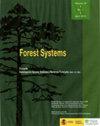半废弃橄榄林植被斑块:利用广义线性混合模型确定面积对木本植物群落组成的影响
IF 0.7
4区 农林科学
Q3 FORESTRY
引用次数: 0
摘要
研究目的:半干旱橄榄林中独特植被栖息地的存在为研究半干旱地中海景观中的植物群落提供了独特的机会。我们通过提供一个新的统计技术的例子,研究了木本植物群落组成在斑块大小梯度上的变化。我们还旨在确定木本植物的共性、生命形式和扩散机制是否是影响不同大小植被斑块中物种存在的关键因素。研究领域:在西班牙中南部的科尔多瓦山脉(Sierra Morena de Córdoba)内选择了三个传统的、部分管理的山地橄榄林(La Soledad、Las Niñas和Piquín)。材料和方法:2020年7月,采用分层随机方法对三片树林斑块内的木本植被进行了采样。鉴定并记录了所有木本植物。使用二项式分布的广义线性混合模型(GLMM)检查了斑块区域内群落组成的变化。主要结果:随着斑块面积的增加,木本植物群落组成发生了显著变化。随着面积的增加,物种发生了更替,其特征是物种的增加。这既是一种普遍趋势,也是一种特定地点的趋势。整个区域的存在模式显示出明显的物种间差异。包括扩散策略和生命形式变量改进的模型拟合,揭示了这些是影响斑块内群落组成的重要因素。研究重点:GLMM分析表明,面积较大的斑块支持更高的丰富度,而不会导致任何物种损失。因此,在半废弃的树林中,保持大片的斑块对于保护木本植物非常重要。本文章由计算机程序翻译,如有差异,请以英文原文为准。
Vegetation patches in semiabandoned olive groves: using generalised linear mixed models to determine the effect of area on community composition of woody plants
Aim of study: The existence of distinct vegetation habitats within semiabandoned olive groves provides a unique chance to study the plant community within semiabandoned Mediterranean landscapes. We investigated changes in community composition of woody plants across a gradient of patch sizes by providing an example of a novel statistical technique. We also aimed to determine if commonness, life form and dispersal mechanisms of woody plants are key factors influencing species presence at vegetation patches of different sizes.
Area of study: Three traditional, partially managed mountain olive groves (La Soledad, Las Niñas and Piquín) were selected within Sierra Morena de Córdoba, in Central Southern Spain.
Material and methods: The woody vegetation within patches at the three groves was sampled in July 2020 following a stratified random approach. All woody plants were identified and recorded. Variation in community composition across patch area was examined using generalised linear mixed models (GLMMs) with a binomial distribution.
Main results: There were significant changes in the community composition of woody plants as patch area increased. There was turnover of species with increasing area, characterised by the gain of species. This was observed both as a general and site-specific trend. Patterns in presence across area showed clear among species variation. Including dispersal strategies and life form variables improved model fit, revealing these are important factors influencing the community composition within the patches.
Research highlights: The GLMM analysis demonstrated that patches of larger areas support higher richness without incurring in any loss of species. Thus, maintaining large patches is important for woody plant conservation within semi-abandoned groves.
求助全文
通过发布文献求助,成功后即可免费获取论文全文。
去求助
来源期刊

Forest Systems
FORESTRY-
CiteScore
1.40
自引率
14.30%
发文量
30
审稿时长
6-12 weeks
期刊介绍:
Forest Systems is an international peer-reviewed journal. The main aim of Forest Systems is to integrate multidisciplinary research with forest management in complex systems with different social and ecological background
 求助内容:
求助内容: 应助结果提醒方式:
应助结果提醒方式:


